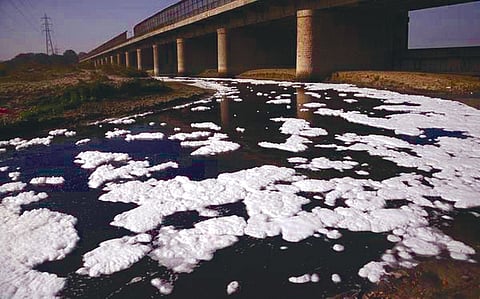Wastewater polluting Yamuna
As many as 88 points have been identified in the district, from where the untreated wastewater containing hazardous chemicals is flowing into drain number 1 and drain number 2. The drain number 2 falls into Yamuna and pollutes it.
Now, the Chairman, Haryana State Pollution Control Board (HSPCB), has sought an action plan from six departments concerned and directed to stop flowing of untreated wastewater into drains to keep the Yamuna clean.
Notably, the Panipat is a textile hub and over 400 registered dyeing units are operating in the city and of which 300 are in Sector 29 part-2 and around 100 in various industrial sectors. Over 200 dyeing units are operating illegally in various areas of the district.
Most of the industries in Sanoli and Bapoli areas in the city are discharging toxic wastewater directly into the Yamuna through tankers.
The drain number-1 is around 8 km long, which heads from the Kabri road to the Chautala road. It meets drain number-2, which leads to Yamuna near Khojkipur village. But, untreated wastewater is polluting both drains at several places in the city.
Varun Gulati, a Delhi based environmentalist said scores of legal or illegal dyeing units were discharging their untreated chemical effluents in the drain number 2 by using tankers also. These tankers could be seen normally in the Sanoli, Bapoli areas in the evening or night time. Besides, scores of bleaching houses are illegally operational and they were discharging untreated effluent directly into Yamuna.
Kamaljeet Singh, regional officer, HSPCB, said, “As many as 88 points have been identified in Panipat through which untreated waste water is flowing into drains.”
“Out of 88 points, 24 are of the Municipal Corporation while 26 are of Panchayati Raj Department. All the departments have been directed to stop draining untreated effluent into drains,” he said.
“However, the HSVP gave in written that all 40 points are only for storm water drainage,” the regional officer maintained.
P Raghwendra Rao, Chairman, HSPCB, said, “The board has decided to curb pollution in Yamuna and Ghaggar. The only aim is that the rivers should be cleaned.”
“For this, the board is reviewing the action district wise, including flowing of untreated wastewater into ditch drains that lead to Yamuna and plan to stop flowing untreated waste water and others into the river. We have reviewed Yamunanagar, Panchkula and Karnal district administration,” he said.
Panipat’s action plan would be reviewed very shortly, the Chairman added.
“Although the HSPCB is the overall regulating authority and has also sought an action plan from the HSVP, the HSIIDC, local bodies, the Public Health Engineering Department (PHED) and the Irrigation Department, so that only treated wastewater flows into drains that fall into Yamuna or Ghaggar,” the Chairman maintained.

